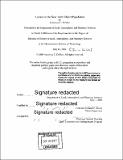| dc.contributor.advisor | Richard P. Binzel. | en_US |
| dc.contributor.author | DeMeo, Francesca E | en_US |
| dc.contributor.other | Massachusetts Institute of Technology. Department of Earth, Atmospheric, and Planetary Sciences. | en_US |
| dc.date.accessioned | 2018-03-27T14:17:26Z | |
| dc.date.available | 2018-03-27T14:17:26Z | |
| dc.date.copyright | 2006 | en_US |
| dc.date.issued | 2006 | en_US |
| dc.identifier.uri | http://hdl.handle.net/1721.1/114322 | |
| dc.description | Thesis: S.B., Massachusetts Institute of Technology, Department of Earth, Atmospheric, and Planetary Sciences, 2006. | en_US |
| dc.description | Cataloged from PDF version of thesis. Original thesis missing pages 14, 15, 17, 30 and 31. | en_US |
| dc.description | Includes bibliographical references (pages 31-32). | en_US |
| dc.description.abstract | Because the lifespan of near-Earth objects (NEOs) is shorter than the age of the solar system, these objects originated elsewhere and they must have a source of re-supply. We seek to determine what fraction of the NEO population consists of dormant or extinct comets. We identify comet candidates among NEOs using three criteria: the Jovian Tisserand parameter Tj < 3, comet nucleus-like spectral parameters (generally linear spectra which correspond to C, D, or P taxonomic types), and low (<0.075) albedos. Out of 31 objects we sample having Tj < 3, we find 17 objects or approximately 55% also satisfy these comet candidate criteria. Bias corrected discovery statistics (Stuart 2003, Ph.D. thesis; Stuart & Binzel 2004, Icarus 170, 295) estimate 30% of the entire NEO population resides in orbits having a value of Tj < 3. Combining these two factors suggests that approximately 16% of the total NEO population has both dynamical and physical properties consistent with a cometary origin. | en_US |
| dc.description.statementofresponsibility | by Francesca E. DeMeo. | en_US |
| dc.format.extent | 32 pages | en_US |
| dc.language.iso | eng | en_US |
| dc.publisher | Massachusetts Institute of Technology | en_US |
| dc.rights | MIT theses are protected by copyright. They may be viewed, downloaded, or printed from this source but further reproduction or distribution in any format is prohibited without written permission. | en_US |
| dc.rights.uri | http://dspace.mit.edu/handle/1721.1/7582 | en_US |
| dc.subject | Earth, Atmospheric, and Planetary Sciences. | en_US |
| dc.title | Comets in the near-Earth object population | en_US |
| dc.type | Thesis | en_US |
| dc.description.degree | S.B. | en_US |
| dc.contributor.department | Massachusetts Institute of Technology. Department of Earth, Atmospheric, and Planetary Sciences | |
| dc.identifier.oclc | 1028738998 | en_US |
